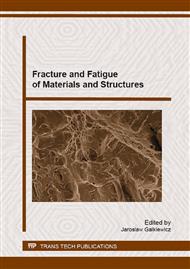[1]
Litwinko R., Oliferuk W., Yield Point Determination Based On Thermomechanical Behaviour Of Polycrystalline Material Under Uniaxial Loading, Acta Mechanica et Automatica, 3 (4), 2009, 49-51.
Google Scholar
[2]
Lipski A., Impact of the Strain Rate During Tension Test on 46Cr1 Steel Temperature Change, Key Engineering Materials, 598, 2014, 133-140.
DOI: 10.4028/www.scientific.net/kem.598.133
Google Scholar
[3]
Lipski A., Lis Z., Temperature Changes Induced by the Portevin-Le Châtelier (PLC) Effect during Tensile Test Based on the Example of CuZn37 Brass. Solid State Phenomena, 224, 2015, 238-243.
DOI: 10.4028/www.scientific.net/ssp.224.238
Google Scholar
[4]
Lipski A., Boroński D., Use of Thermography for the Analysis of Strength Properties of Mini-Specimens, Materials Science Forum, 726, 2012, 156-161.
DOI: 10.4028/www.scientific.net/msf.726.156
Google Scholar
[5]
Doudard C., Poncelet M., Calloch S., Boue C., Hild F., Galtier A., Determination of an HCF criterion by thermal measurements under biaxial cyclic loading, International Journal of Fatigue, 29 (4), 2007, 748–757.
DOI: 10.1016/j.ijfatigue.2006.06.009
Google Scholar
[6]
Poncelet M., Doudard C., Calloch S., Weber B., Hild F., Probabilistic multiscale models and measurements of self-heating under multiaxial high cycle fatigue, Journal of Mechanics and Physics of Solids, 58 (4), 2010, 578–593.
DOI: 10.1016/j.jmps.2010.01.003
Google Scholar
[7]
Lipski A., Skibicki D., Variations Of The Specimen Temperature Depending On The Pattern Of The Multiaxial Load - Preliminary Research, Materials Science Forum, 726, 2012, 162-168.
DOI: 10.4028/www.scientific.net/msf.726.162
Google Scholar
[8]
Skibicki D., Sempruch J., Lipski A., Pejkowski Ł., Fatigue Life, Fractographic and Thermographic Analysis of Steel X2CrNiMo17-12-2 for Proportional and Non-Proportional Loads, The Tenth International Conference on Multiaxial Fatigue & Fracture, Kyoto (Japan), (2013).
DOI: 10.4028/www.scientific.net/msf.726.171
Google Scholar
[9]
Ligaj B., Szala G., Comparative analysis of fatigue life calculation methods of C45 steel in conditions of variable amplitude loads in the low- and high-cycle fatigue ranges. Polish Maritime Research, 19 (4), 2012, 23-30.
DOI: 10.2478/v10012-012-0037-z
Google Scholar
[10]
Szala G., Ligaj B., Effect of the exponent in the description of Wöhler fatigue diagram on the results of calculations of fatigue life. Key Engineering Materials, 598, 2014, 231-236.
DOI: 10.4028/www.scientific.net/kem.598.231
Google Scholar
[11]
Pejkowski Ł., Skibicki D., Sempruch J., High-Cycle Fatigue Behavior of Austenitic Steel and Pure Copper under Uniaxial, Proportional and Non-Proportional Loading. Strojniski Vestnik-Journal Of Mechanical Engineering, 60 (9), 2013, 549-560.
DOI: 10.5545/sv-jme.2013.1600
Google Scholar
[12]
Skibicki D., Sempruch J., Pejkowski Ł., Model of non-proportional fatigue load in the form of block load spectrum, Materialwissenschaft Und Werkstofftechnik, 45 (2), 2014, 68-78.
DOI: 10.1002/mawe.201400206
Google Scholar
[13]
Tomaszewski T., Sempruch J., Verification of the fatigue test method applied with the use of mini specimen. Key Engineering Materials, 598, 2014, 243-248.
DOI: 10.4028/www.scientific.net/kem.598.243
Google Scholar
[14]
Tomaszewski T, Sempruch J., Piątkowski T., Verification of selected models of size effect based on high-cycle fatigue testing on mini specimens made of EN AW-6063 aluminum alloy. Journal of Theoretical and Applied Mechanics. 52 (4), 2014, 883-894.
DOI: 10.15632/jtam-pl.52.4.883
Google Scholar
[15]
Collins J.A., Failure of Materials in Mechanical Design - Analysis, Prediction, Prevention. John Wiley & Sons, (1993).
Google Scholar
[16]
Lipski A., Determination of Fatigue Limit by Locati Method using S-N Curve Determined by Means of Thermographic Method, Solid State Phenomena, 223, 2015, 362-373.
DOI: 10.4028/www.scientific.net/ssp.223.362
Google Scholar
[17]
La Rosa G., Risitano A., Thermographic methodology for rapid determination of the fatigue limit of materials and mechanical components. International Journal of Fatigue, 22 (1), 2000, 65-73.
DOI: 10.1016/s0142-1123(99)00088-2
Google Scholar
[18]
Luong M.P., Infrared thermographic scanning of fatigue in metals. Nuclear Engineering and Design, 158 (2-3), 1995, 363-376.
DOI: 10.1016/0029-5493(95)01043-h
Google Scholar
[19]
Luong M.P., Fatigue limit evaluation of metals using an infrared thermographic technique. Mechanics of Materials, 28 (1), 1998, 155–163.
DOI: 10.1016/s0167-6636(97)00047-1
Google Scholar
[20]
Cura F., Curti G., Sesana R., A new iteration method for the thermographic determination of fatigue limit in steels. International Journal of Fatigue, 27 (4), 2005, 453-459.
DOI: 10.1016/j.ijfatigue.2003.12.009
Google Scholar
[21]
Galietti U., Palumbo D., De Finis R., Ancona F., Fatigue limit evaluation of martensitic steels with thermal methods. The 12th International Conference of Quantitative Infrared Thermography, QIRT, Bordeaux, (2014).
DOI: 10.21611/qirt.2014.105
Google Scholar
[22]
Kordatos E.Z., Dassios K.G., Aggelis D.G., Matikas T.E., Rapid evaluation of the fatigue limit in composites using infrared lock-in thermography and acoustic emission. Mechanics Research Communications, 54, 2013, 14–20.
DOI: 10.1016/j.mechrescom.2013.09.005
Google Scholar
[23]
Li X.D., Zhang H., Wu D.L., Liu X., Liu J.Y., Adopting lock-in infrared thermography technique for rapid determination of fatigue limit of aluminum alloy riveted component and affection to determined result caused by initial stress. International Journal of Fatigue, 36 (1), 2012, 18-23.
DOI: 10.1016/j.ijfatigue.2011.09.005
Google Scholar
[24]
Fargione G., Geraci A., La Rosa G., Risitano A., Rapid determination of the fatigue curve by the thermographic method. International Journal of Fatigue, 24 (1), 2002, 11-19.
DOI: 10.1016/s0142-1123(01)00107-4
Google Scholar
[25]
Amiri M., Khonsari M.M., Life prediction of metals undergoing fatigue load based on temperature evolution. Materials Science and Engineering A, 527 (6), 2010, 1555–1559.
DOI: 10.1016/j.msea.2009.10.025
Google Scholar
[26]
Amiri M., Khonsari M.M., Rapid determination of fatigue failure based on temperature evolution: Fully reversed bending load. International Journal of Fatigue, 32 (2), 2010, 382-389.
DOI: 10.1016/j.ijfatigue.2009.07.015
Google Scholar
[27]
Golański G., Mroziński S., Fatigue life of GX12CrMoVNbN9-1 cast steel in the energy-based approach. Advanced Materials Research, 396-398, 2012, 446-449.
DOI: 10.4028/www.scientific.net/amr.396-398.446
Google Scholar
[28]
Lipski A., Accelerated Determination of the Fatigue Limit and the S-N Curve by Means of the Thermographic Method for X5CrNi18-10 Steel. 8-th International Symposium on Mechanics of Materials and Structures, May 31 – June 3, 2015, Augustow, Poland.
DOI: 10.1515/ama-2016-0004
Google Scholar
[29]
Dixon W.J., Mood A.M., A Method for Obtaining and Analyzing Sensitivity Data, Journal of the American Statistical Association. 43 (241), 1948, 109-126.
DOI: 10.1080/01621459.1948.10483254
Google Scholar


